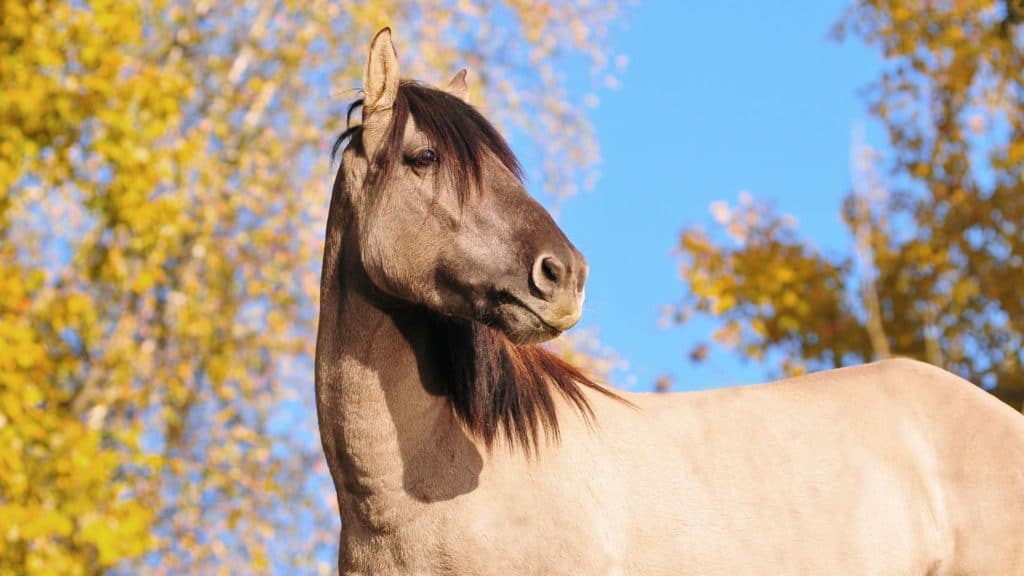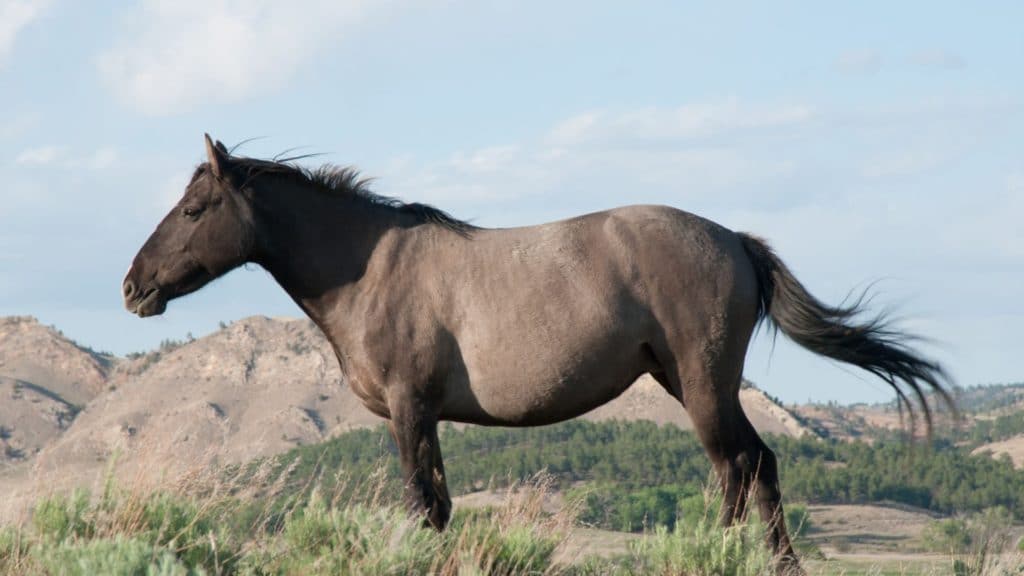Last updated: May 29, 2025
Have you ever wondered why grullo horses captivate the hearts of equestrians worldwide? Grulla horses, characterized by their unique silver-gray to deep slate coat color, owe their stunning appearance to a specific genetic combination, including the dun gene. This gene not only gifts them with their distinctive hue but also often adorns them with primitive markings like dorsal stripes.
As someone who has been raised around horses and previously owned a grullo horse, I’ve witnessed firsthand their value across various equestrian disciplines. Join me as we explore the rarity and beauty that make grullo horses a prized possession and a fascinating subject within the horse community.

Characteristics of Grulla Horses
Grulla horses, known for their unique coat color and primitive markings, are a fascinating study in equine genetics and beauty. Part of the dun horse group, they exhibit a range of distinctive features that set them apart in the equine world.
Distinctive Markings:
- Dorsal Stripes: A defining characteristic running along the spine.
- Shoulder Stripes or Shadowing: Adding to their striking appearance.
- Leg Barring or Striping: Visible on the lower legs, enhancing their distinct look.
- Additional Traits: Some may also have forehead stripes (cobwebs), dark rings around their eyes, and mottled patterns on their shoulders and legs.
Color Variations
Grulla horses come in various shades influenced by the dun dilution gene, including:
- Black Dun: Deep, dark shades close to black.
- Blue Dun: Exhibiting a cooler, bluish-gray tint.
- Slate Grulla: A medium to dark slate gray.
- Silver or Light Grulla: Almost silver-gray, lighter than the classic shades.
- Silver Dun and Lobo Dun: Unique variations adding to the spectrum of grulla colors.

Physical Features:
- Dark-Tipped Ears: A common trait among grulla horses.
- Large Head: Proportionally larger compared to their body size.
- Dark Legs: Usually black or brown, contributing to their striking appearance.
Size Considerations: Grulla horses can vary in size but are identified by their coat criteria rather than height, fitting both horse and pony classifications.
Mane and Tail: Being black-based colors, grulla horses typically have black manes and tails.

Grulla Horse Genetics Simplified
The genetics of a grullo horse involve a specific combination of alleles related to coat color and the presence of the dun dilution factor. Let’s take a look at the genes that create Grulla horses:
Base Coat Color:
- Black Base: Needs at least one dominant “E” allele.
- Genetic Representation: “EE” (homozygous) or “Ee” (heterozygous).
Dun Dilution Factor:
- Key to Grullo Color: Must have the dun gene to dilute the black base coat.
- Genetic Codes: “DD” (homozygous for dun, showing a strong dilution effect) or “Dd” (heterozygous, still displaying the dilution).
Combination for Grullo:
- Essential Genes: “E” for black base + “D” for dun dilution.
- Possible Genotypes: EE/DD, EE/Dd, Ee/DD, Ee/Dd.
Visual Breakdown:
- E_: Ensures a black base coat.
- D_: Introduces the dun dilution, creating the grullo shade.
Dive into the captivating world of Grulla horses with this insightful YouTube video.
Inheritance and Rarity:
The genetic mechanics behind the grullo color are a fascinating study in inheritance, contributing to the rarity and special status of these horses. The precise combination of genes required to produce the grullo coloration makes each grullo horse a unique masterpiece of nature.
Interesting Fact: Grullo vs. Grulla
- Language Origins: Derived from Spanish, where gender influences noun forms.
- Grullo: Refers to male horses (stallions or geldings) with a unique smoky-gray or mouse-colored coat.
- Grulla: Used for female horses (mares) showcasing the same distinctive dun-diluted coat color.
- Common Usage: In English, the terms are often used interchangeably, though they carry gender-specific meanings in Spanish.
Horse Breeds Featuring Grulla Coloration
Grulla can be found across various horse breeds. This coloration is the result of the dun gene acting on a black base coat, creating shades from silvery gray to deep slate. Here’s a look at some breeds where grulla horses are commonly seen:

- Quarter Horse: Known for their versatility, Quarter Horses often display beautiful grulla coloration, especially valued in Western disciplines.
- Mustang: Wild Mustangs, with their diverse genetic background, frequently exhibit the grulla coat, showcasing the color’s natural beauty in the wild.
- Icelandic Horse: This breed, known for its hardiness and unique gaits, can also come in grulla, adding to the breed’s array of stunning colors.
- Lusitano: The grulla color is less common in this Portuguese breed but is highly prized when it does appear, highlighting the breed’s elegance.
- Andalusian: While grulla is rare in Andalusians, those that do display this color stand out for their striking appearance against the breed’s traditional gray, bay, and black coats.
- Morgan Horse: Morgans, one of the oldest American breeds, can also be grulla, though it’s a less common color for the breed.
- Norwegian Fjord: One of the few breeds where the dun gene is nearly universal, resulting in a high likelihood of grulla coloration, though their specific dun variations are often referred to by different names.

Grulla Horse Origin
Grullo horses have been revered for their unique beauty and strength, captivating people across ages. In many cultures, they symbolize resilience, elegance, and power, making them more than just horses.
Cultural Footprint:
- Historical Artifacts: Grullo horses frequently appear in ancient art, showcasing their importance in early human societies.
- Literary Mentions: From epic poems to classic tales, grullo horses have trotted through pages of literature, symbolizing various themes.
- Folklore and Myth: These horses often feature in legends, embodying qualities like wisdom and bravery, and sometimes even magical powers.
Geographical Significance:
- Global Distribution: While thought to originate from Europe and Asia, grullo horses have made their mark worldwide, adapting to various environments.
- Role in History: They have served in countless roles, from war mounts to agricultural helpers, showcasing their versatility and resilience.
Genetic Journey:
- Survival of the Gene: The dun gene responsible for the grullo coloration has persisted through natural selection, indicating its advantageous traits.
- Breed Development: Over time, selective breeding has emphasized the grullo color in various horse breeds, celebrating its beauty and rarity.

FAQs on Grulla Horses
What is a grulla horse?
A grulla horse is known for its unique coat color, resulting from the dun dilution gene acting on a black base coat. This gives them a range of shades from tan-gray to mouse-colored, along with distinctive primitive markings.
What are the distinctive markings of a grulla horse?
Grulla horses often have dorsal stripes along their spine, leg barring or striping, and sometimes shoulder stripes or shadowing. Additional markings can include forehead stripes, dark rings around their eyes, and mottled patterns on their shoulders and legs.
Can grulla horses be any size?
Yes, grulla horses can vary in size from ponies to full-sized horses. The classification between a horse and a pony is based on height, but grulla horses can belong to either category as long as they meet the coat criteria.
What color variations do grulla horses come in?
Grulla horses can appear in several color variations, including black dun, blue dun, slate grulla, silver or light grulla, silver dun, and lobo dun. These variations depend on the specific interaction of the dun gene with the black base coat.
How can you tell a grulla foal from a dun foal?
Grulla foals are typically born a light tan color with a distinct dorsal stripe and black hair around the eyes and across the nose’s bridge. In contrast, dun foals have golden, orange, or brown hair in those areas.
Are grulla horses rare?
Yes, grulla horses are considered rare due to the specific genetic combination required to produce their unique coat color and markings. This rarity adds to their appeal among horse enthusiasts.
Can any horse breed be grulla?
While grulla coloration can occur in many breeds, it is more common in breeds that carry the dun gene. Breeds like Quarter Horses, Mustangs, and Icelandic Horses are known to have grulla individuals.
Conclusion: The Unique Charm of Grullo Horses
Grullo horses stand out in the equine world with their smoky-gray to deep slate coats and distinctive dun striping, embodying a blend of beauty, strength, and versatility. Their rarity and historical significance across cultures make interacting with them a privilege, offering a deep connection to their storied past and genetic heritage.
Additional Resources
- International Buckskin Horse Association (IBHA): While focused on buckskin horses, IBHA also caters to other colors influenced by the dun gene, including grullo. Visit IBHA
- American Quarter Horse Association (AQHA): Given the prevalence of grullo coloration in Quarter Horses, the AQHA is a pivotal resource for enthusiasts. Visit AQHA
- Norwegian Fjord Horse Registry (NFHR): The Fjord horse often exhibits dun variations, closely related to grullo coloration. Visit NFHR
- American Paint Horse Association (APHA): Paint horses can display a wide range of colors, including grullo, within their unique coat patterns. Visit APHA

About the Author: Miles Henry
Lifelong Horseman | Racehorse Owner | Published Author
Miles Henry brings over 25 years of hands-on experience training and owning Thoroughbred racehorses. Raised with Quarter Horses and Appaloosas, he’s spent a lifetime learning from horses—on the track, in the barn, and in the field. Today, he runs a small but successful racing stable in Louisiana and shares real-world insights on HorseRacingSense.com, helping horse owners, fans, and bettors navigate the sport with confidence.
📚 Books: View Miles’s books on Amazon »
🎧 Podcast Guest: Animal Tales Ep. 32 |
YouTube Interview
📩 Newsletter: Sign up for racing tips and horse care advice »
🔗 Follow Miles:
Twitter |
Facebook |
YouTube


